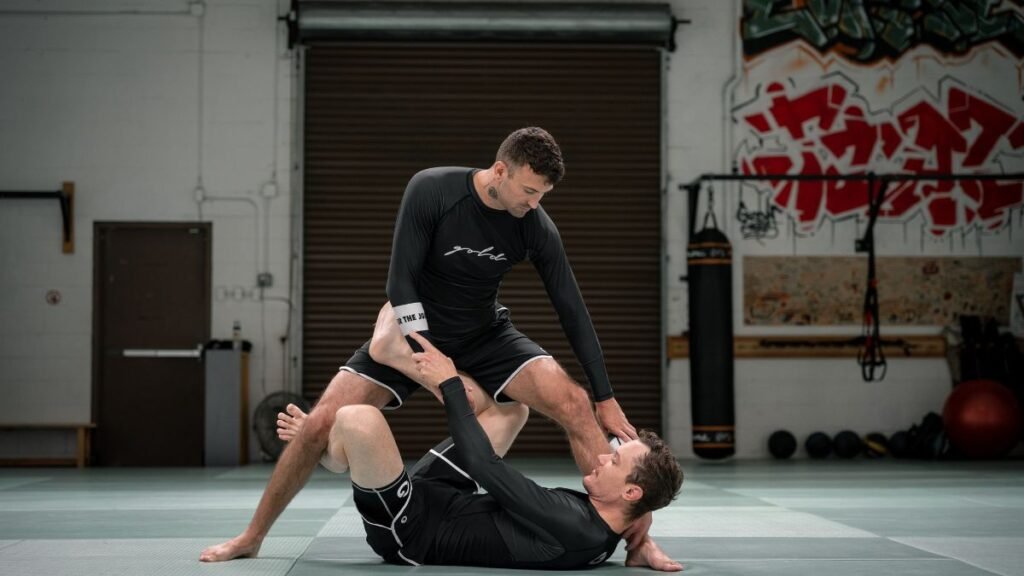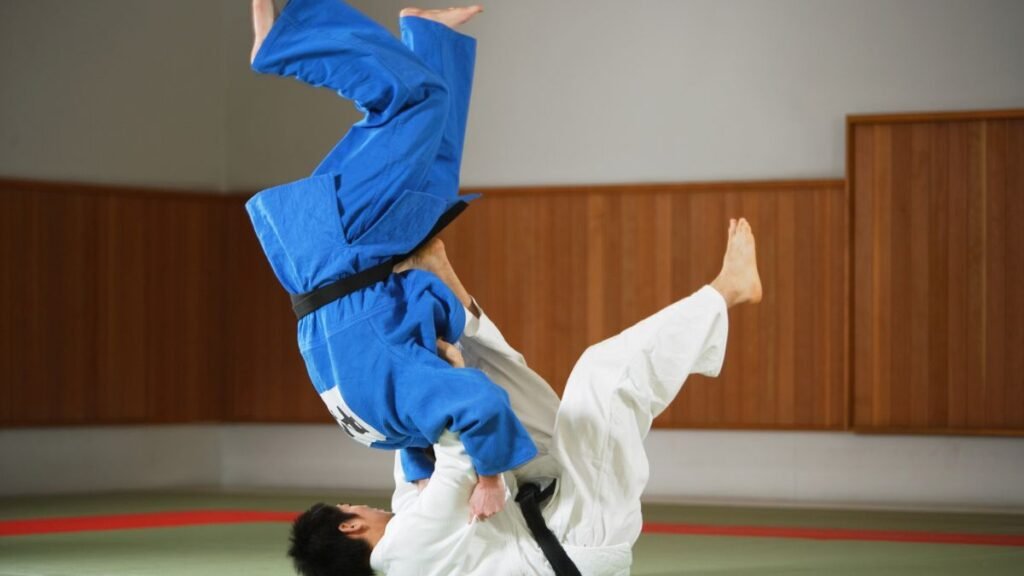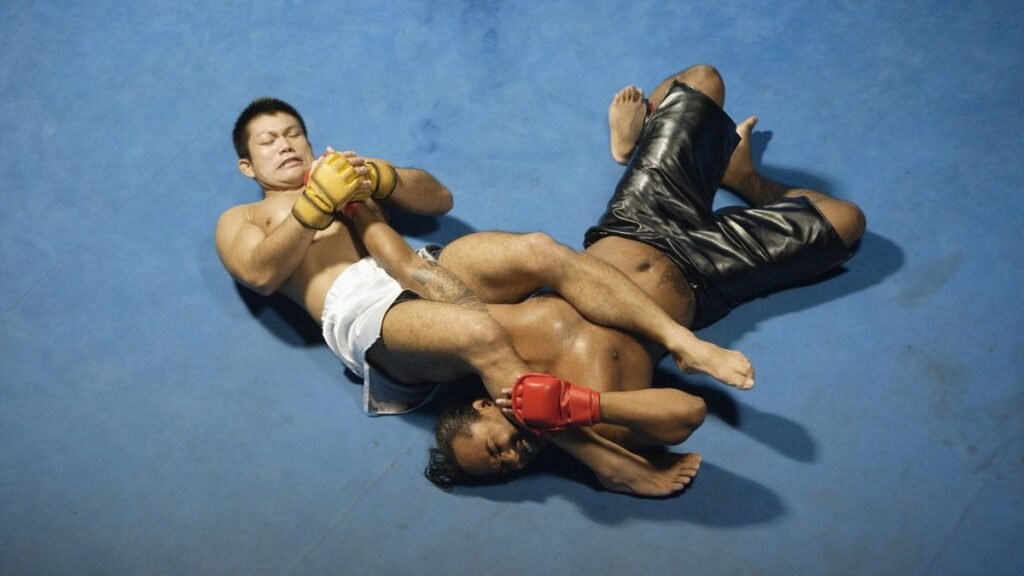Introduction
Have you ever wondered how two martial arts rooted in Japanese tradition became global phenomena, thanks to Brazil? The story of Jiu Jitsu and Judo is not just about techniques or fighting styles. It’s about cultural adaptation, innovation, and the relentless pursuit of excellence.
Brazil’s unique role in shaping these disciplines is undeniable. The Gracie family revolutionized Jiu Jitsu, transforming it into a ground-based combat system that dominates modern sports. Meanwhile, Judo gained Olympic recognition in 1964, solidifying its place in martial arts history.

This article explores the fascinating journey of these martial arts in Brazil. From their historical growth to their modern impact, we’ll uncover how they evolved into global sports. Discover the key differences in techniques, training, and competition formats that set them apart.
Key Takeaways
- Brazil played a pivotal role in evolving Jiu Jitsu and Judo globally.
- The Gracie family’s innovations transformed Jiu Jitsu into a dominant martial art.
- Judo became an Olympic sport in 1964, gaining worldwide recognition.
- Both disciplines emphasize unique techniques and training methods.
- Their cultural adaptation in Brazil shaped their modern impact.
Introduction to Jiu Jitsu and Judo
Brazil’s influence on martial arts extends beyond borders, shaping disciplines like Judo and Brazilian Jiu-Jitsu. Both arts trace their roots to Japan but have evolved uniquely in Brazil, becoming global phenomena.
Judo emphasizes throws and standing techniques, focusing on speed and force. Its philosophy centers on “maximum efficiency,” using an opponent’s energy against them. In contrast, Brazilian Jiu-Jitsu prioritizes ground fighting and submissions, relying on leverage rather than strength.
Despite their shared origins in self-defense, these combat styles have distinct philosophies. Judo’s focus on quick throws contrasts with Brazilian Jiu-Jitsu’s detailed ground grappling techniques. Both have gained immense popularity in Brazil and globally, influencing modern sports and fitness trends.
For a deeper understanding of the difference between Judo and Brazilian Jiu-Jitsu, explore their unique training methods and competition formats.
| Aspect | Judo | Brazilian Jiu-Jitsu |
|---|---|---|
| Focus | Throws and standing techniques | Ground fighting and submissions |
| Philosophy | Maximum efficiency | Leverage over strength |
| Popularity | Global, especially in Olympic sports | Global, with a strong presence in MMA |
The Origins of Judo and Brazilian Jiu-Jitsu
The roots of Judo and Brazilian Jiu-Jitsu trace back to Japan, but their evolution in Brazil shaped their global identity. These martial arts began as traditional Japanese practices but were transformed into modern disciplines through innovation and cultural adaptation.
The Birth of Judo in Japan
Judo was founded in 1882 by Jigoro Kano, who modernized traditional jujutsu. Kano emphasized moral development and physical fitness, referring to his discipline as the “gentle way.” His philosophy focused on using an opponent’s energy against them, promoting efficiency over brute strength.
In 1964, Judo gained Olympic recognition, solidifying its place as a global martial art. Kano’s teachings extended beyond techniques, emphasizing respect, discipline, and self-improvement. This holistic approach made Judo a respected art worldwide.
The Gracie Family and the Rise of Brazilian Jiu-Jitsu
Mitsuyo Maeda, a Judo expert, introduced the discipline to Brazil in 1914. He trained Carlos and Helio Gracie, who adapted Judo’s ground techniques to create Brazilian Jiu-Jitsu. The Gracie family refined these methods, focusing on leverage and technique to overcome larger opponents.
Their innovations dominated Vale Tudo fights, showcasing the effectiveness of ground fighting. Brazilian Jiu-Jitsu has become a cornerstone of modern martial arts, influencing mixed martial arts (MMA) and self-defense systems worldwide.
| Aspect | Judo | Brazilian Jiu-Jitsu |
|---|---|---|
| Origin | Japan, 1882 | Brazil, early 20th century |
| Founder | Jigoro Kano | Gracie Family |
| Focus | Throws and standing techniques | Ground fighting and submissions |
Philosophies Behind Judo and Brazilian Jiu-Jitsu
The philosophies of these two martial arts reveal their unique approaches to combat and self-improvement. While both emphasize efficiency and adaptability, their core principles differ significantly. These philosophies not only shape their techniques but also influence their training methods and real-world applications.
Judo: The Gentle Way
Judo, often referred to as the “gentle way,” is built on the principle of seiryoku zenyo, or maximum efficiency. This philosophy teaches practitioners to use an opponent’s momentum against them, minimizing the need for brute strength. Throws and standing techniques are central to this approach, focusing on speed and precision.
Beyond physical techniques, Judo emphasizes mental discipline and respect. It promotes physical fitness while fostering a mindset of continuous improvement. This holistic approach has made Judo a respected martial art worldwide, with benefits extending beyond the mat.
Brazilian Jiu-Jitsu: Leverage and Technique Over Strength
Brazilian Jiu-Jitsu (BJJ) prioritizes leverage and technique over physical strength. Its philosophy enables smaller practitioners to defeat larger opponents through strategic ground fighting and submissions. This pragmatic approach makes BJJ highly effective in real-world self-defense scenarios.
BJJ’s focus on detailed techniques and positional control sets it apart. Practitioners learn to dominate on the ground, using submissions to neutralize threats. This emphasis on strategy and adaptability has made BJJ a cornerstone of modern combat sports.
Techniques and Focus: Judo vs. Brazilian Jiu-Jitsu
The techniques of these two martial arts highlight their distinct approaches to combat. While one emphasizes powerful throws, the other focuses on intricate ground maneuvers. Understanding these differences provides insight into their unique effectiveness.

Judo: Throws and Standing Techniques
Judo’s foundation lies in its throws and standing techniques. Practitioners aim to use an opponent’s momentum against them, achieving quick and decisive victories. Techniques like osoto-gari (major outer reap) and hip throws are central to this discipline.
Matches can end instantly with an ippon throw, where the opponent lands forcefully on their back. This focus on speed and precision makes Judo a dynamic and efficient martial art. Groundwork is limited, with most action occurring while standing.
Brazilian Jiu-Jitsu: Ground Fighting and Submissions
In contrast, Brazilian Jiu-Jitsu excels in ground fighting and submissions. Practitioners use leverage and technique to control their opponent, often from inferior positions. Guard passes, armbars, and rear-naked chokes are key components of this art.
Points are awarded for positional dominance, such as achieving mount or back control. The extensive groundwork enables strategic maneuvering and precise execution of joint locks and chokes. This approach is highly effective for both self-defense and competition.
Training Methods in Judo and Brazilian Jiu-Jitsu
The training methods in Judo and Brazilian Jiu-Jitsu reveal their unique approaches to skill development. Both disciplines emphasize physical fitness and focus, but their techniques and goals differ significantly. Understanding these methods provides insight into how practitioners master their craft.
Randori and Kata
In Judo, randori (live sparring) is a cornerstone of training. It allows students to practice throws and standing techniques in a dynamic setting. This method hones reflexes and adaptability, preparing practitioners for real-world scenarios.
Kata, or forms, are another essential component. These prearranged sequences teach precision and control. Breakfall drills are also critical, as they ensure students learn to fall safely and prevent injuries during practice.
Rolling and Positional Sparring
Brazilian Jiu-Jitsu emphasizes rolling, a form of live sparring that mimics real fights. This method focuses on transitions, submissions, and positional control. Practitioners start in specific positions, such as side control, to refine their strategies.
Positional sparring is particularly effective for mastering ground techniques. It allows students to practice escapes, sweeps, and submissions in a controlled environment. This approach builds confidence and technical proficiency.
| Aspect | Judo | Brazilian Jiu-Jitsu |
|---|---|---|
| Primary Training | Randori (live sparring) | Rolling (live sparring) |
| Forms | Kata (prearranged sequences) | Positional Sparring |
| Belt Progression | 12 ranks | Longer promotion timelines |
Belt progression in Judo includes 12 ranks, with a structured system for advancement. Brazilian Jiu-Jitsu, on the other hand, has a more extended timeline, reflecting its detailed curriculum. Both systems reward dedication and skill development.
Competition Formats: Judo vs. Brazilian Jiu-Jitsu
Competition formats in martial arts often define their unique appeal and strategy. The way athletes compete in these disciplines highlights their core philosophies and technical depth. From quick throws to detailed ground maneuvers, the rules and scoring systems set them apart.
Throws, Pins, and Submissions
In Judo, matches are fast-paced and decisive. Victory can be achieved through an ippon, a perfect throw that lands the opponent on their back with force. Alternatively, a 20-second pin or a successful submission can also secure a win. These rules emphasize speed and precision, making Judo a dynamic spectator sport.
Recent rule changes, such as bans on leg grabs, have streamlined the sport. These adjustments aim to preserve Judo’s traditional focus on throws and standing techniques. Iconic competitors like Ronda Rousey have showcased the effectiveness of these methods on the global stage.
Points and Submission-Only Tournaments
Brazilian Jiu-Jitsu competitions, on the other hand, often feature longer matches. The International Brazilian Jiu-Jitsu Federation (IBJJF) awards points for sweeps, guard passes, and dominant positions. This scoring system rewards strategic control and technical mastery.
Submission-only tournaments, such as the ADCC trials, focus solely on forcing an opponent to submit. These events highlight the art’s pragmatic approach to combat. Royce Gracie’s dominance in early MMA events cemented BJJ’s reputation as a highly effective martial art.
- Judo matches are quick, often decided by a single throw or pin.
- BJJ competitions emphasize positional control and submissions.
- Rule differences, like Judo’s leg-grab bans vs. BJJ’s allowance for heel hooks, reflect their distinct philosophies.
Both disciplines offer unique challenges and rewards, attracting athletes at every level of competition. Whether through the explosive throws of Judo or the intricate ground game of BJJ, these sports continue to captivate audiences worldwide.
The Growth of Judo and Brazilian Jiu-Jitsu in Brazil
From military training to global recognition, Brazil’s influence on martial arts is undeniable. The country’s unique cultural landscape provided fertile ground for the evolution of these disciplines, transforming them into global phenomena.
Judo’s Influence on Brazilian Martial Arts
Judo became an integral part of Brazil’s military training in the early 20th century. Its emphasis on discipline and physical fitness aligned perfectly with the needs of the armed forces. Over time, Judo was integrated into physical education programs across the country, fostering a culture of respect and self-improvement.
This widespread adoption helped Judo gain a strong foothold in Brazil. The sport not only improved physical health but also instilled values like perseverance and humility. Today, Judo remains a cornerstone of Brazilian martial arts, with many practitioners achieving international acclaim.
Brazilian Jiu-Jitsu’s Global Expansion
The Gracie family played a pivotal role in the global expansion of Brazilian Jiu-Jitsu. After establishing the first academy in Rio de Janeiro in 1925, they refined the styles to emphasize leverage and technique over strength. This innovation made the art accessible to people of all sizes and skill levels.
The effectiveness of Brazilian Jiu-Jitsu was showcased at UFC 1 in 1993, sparking worldwide interest. The International Brazilian Jiu-Jitsu Federation (IBJJF) further standardized competitions, ensuring consistent rules and promoting the sport globally. Today, academies can be found in the United States, Europe, and beyond, offering benefits such as self-defense skills and physical fitness.
For a deeper dive into the history of Brazilian Jiu-Jitsu, explore this detailed resource.
Key Differences Between Judo and Brazilian Jiu-Jitsu
Understanding the distinctions between these two martial arts reveals their unique strengths. While both share a common origin, their techniques, rules, and philosophies have evolved in distinct ways. This section examines the primary differences that distinguish them.

Standing vs. Ground Techniques
Judo emphasizes standing techniques, with a focus on throws and takedowns. The goal is to use an opponent’s momentum against them, often ending a match with a single, decisive throw. Groundwork is limited, and prolonged grappling is penalized.
In contrast, Brazilian Jiu-Jitsu (BJJ) excels in ground techniques. Practitioners aim to control their opponent through positional dominance and submissions. The art encourages thorough groundwork, enabling strategic maneuvering and precise execution of techniques.
Scoring Systems and Rules
Judo’s scoring system rewards explosive throws and quick pins. A perfect throw, known as an ippon, ends the match immediately. Points are also awarded for pins lasting 20 seconds or successful submissions. Recent rule changes, like banning leg grabs, maintain the focus on standing techniques.
BJJ competitions utilize a points system that rewards guard passes, sweeps, and dominant positions, such as mount or back control. Submission-only tournaments highlight the art’s pragmatic approach, focusing solely on forcing an opponent to tap out. Leg locks are allowed, adding another layer of complexity.
| Aspect | Judo | Brazilian Jiu-Jitsu |
|---|---|---|
| Focus | Throws and standing techniques | Ground fighting and submissions |
| Scoring | Ippon, pins, submissions | Points for positional control |
| Rules | Leg grabs restricted | Leg locks allowed |
These differences reflect the unique philosophies of each art. Judo’s emphasis on speed and efficiency contrasts with BJJ’s methodical approach to ground control. Both disciplines offer valuable skills for students at every level, making them complementary in the world of martial arts.
The Impact of Judo and Brazilian Jiu-Jitsu on Modern Martial Arts
The global rise of these disciplines has reshaped the landscape of modern combat sports. From Olympic stages to MMA arenas, their influence is undeniable. Both arts have inspired countless practitioners, offering unique benefits that extend beyond physical fitness.
Judo in the Olympics
Judo’s Olympic debut in 1964 marked a turning point for the sport. Its inclusion in the Games brought global recognition and legitimacy. The discipline’s emphasis on throws and standing techniques captivated audiences worldwide.
Judo has also influenced other grappling styles, such as Sambo. Its principles of efficiency and adaptability have been adopted by various martial arts. Athletes like Kayla Harrison have showcased Judo’s effectiveness on the international stage, winning multiple Olympic medals.
Brazilian Jiu-Jitsu in Mixed Martial Arts
Brazilian Jiu-Jitsu has become a cornerstone of MMA, with 90% of UFC fighters training in the art. Its focus on ground fighting and submissions has revolutionized combat sports. Legends like Demian Maia and Fabricio Werdum have demonstrated BJJ’s dominance in the octagon.
Submission-only tournaments, such as ADCC, highlight the discipline’s technical depth. Athletes like Gordon Ryan have pushed the boundaries of what’s possible in BJJ, inspiring a new generation of practitioners.
- Judo’s Olympic status has elevated its global profile.
- BJJ’s influence on MMA has made it a must-learn art for fighters.
- Crossover athletes like Kayla Harrison and Gordon Ryan bridge the gap between these styles.
Why Jiu-Jitsu and Judo Thrived in Brazil
Brazil’s unique cultural landscape played a pivotal role in the global rise of these martial arts. The country’s openness to innovation and its vibrant combat culture created the perfect environment for their growth. This section examines how cultural acceptance and the efforts of key figures, such as the Gracie family, contributed to their success.
Cultural Acceptance and Adaptation
Brazil’s Vale Tudo culture provided a testing ground for the effectiveness of these martial arts. Vale Tudo, meaning “anything goes,” was a no-holds-barred combat style that allowed practitioners to showcase their skills and abilities. This environment encouraged innovation and adaptation, making Brazil a hub for martial arts development.
Judo’s emphasis on discipline resonated deeply with Brazilian values. Its integration into military training and physical education programs fostered a culture of respect and self-improvement. This widespread adoption helped Judo gain a strong foothold in the country.
The Role of the Gracie Family
The Gracie family played a pivotal role in popularizing Brazilian Jiu-Jitsu. Through the Gracie Challenge matches in the 1920s-1950s, they demonstrated the art’s effectiveness against larger opponents. These matches solidified BJJ’s reputation as a practical and powerful martial art.
Their marketing strategies, including UFC 1 and instructional videos, brought BJJ to a global audience. The proliferation of academies in São Paulo and Rio de Janeiro further cemented their place in Brazilian culture. Today, the Gracie family’s legacy continues to inspire students worldwide.
| Aspect | Cultural Acceptance | Gracie Family’s Role |
|---|---|---|
| Key Influence | Vale Tudo culture | Gracie Challenge matches |
| Impact | Integration into Brazilian society | Global expansion of BJJ |
| Legacy | Respect and discipline | Modern martial arts dominance |
Conclusion: The Legacy of Jiu-Jitsu and Judo in Brazil
The journey of these martial arts from Brazil to the world stage is a testament to their enduring legacy. Both disciplines have profoundly transformed Brazilian culture and left a lasting impact on the global landscape of combat sports. The Gracie family’s innovations and Kano’s foundational philosophies continue to inspire practitioners worldwide.
These arts offer more than just physical techniques. They promote discipline, mental resilience, and personal growth. Whether for self-defense or physical fitness, they provide valuable benefits for individuals of all ages and skill levels.
Interested in exploring these disciplines? With BJJ’s 40% growth in U.S. gym memberships since 2015, there’s never been a better time to start training. Embrace the legacy and discover how these martial arts can enrich your life. Learn more about World Beach Volleyball.
FAQ
What are the origins of Judo and Brazilian Jiu-Jitsu?
Judo originated in Japan, founded by Jigoro Kano in the late 19th century. Brazilian Jiu-Jitsu evolved from Judo, introduced to Brazil by Mitsuyo Maeda and further developed by the Gracie family.
How do the philosophies of Judo and Brazilian Jiu-Jitsu differ?
Judo emphasizes “The Gentle Way,” focusing on using an opponent’s energy against them. Brazilian Jiu-Jitsu prioritizes leverage and technique over physical strength, especially in ground fighting.
What techniques are emphasized in Judo versus Brazilian Jiu-Jitsu?
Judo focuses on throws and standing techniques, while Brazilian Jiu-Jitsu specializes in ground fighting, submissions, and positional control.
How do training methods differ between the two martial arts?
Judo training includes randori (sparring) and kata (forms), while Brazilian Jiu-Jitsu emphasizes rolling and positional sparring to simulate real combat scenarios.
What are the main differences in competition formats?
Judo competitions score points for throws, pins, and submissions. Brazilian Jiu-Jitsu tournaments use a points system or focus solely on submission-only matches.
Why did Judo and Brazilian Jiu-Jitsu thrive in Brazil?
Both arts gained cultural acceptance in Brazil, with the Gracie family playing a pivotal role in adapting and promoting Brazilian Jiu-Jitsu globally.
How have Judo and Brazilian Jiu-Jitsu influenced modern martial arts?
Judo became an Olympic sport, while Brazilian Jiu-Jitsu had a significant impact on mixed martial arts (MMA) through its effective ground techniques.
What are the key differences in scoring systems between the two?
Judo scores based on throws, pins, and submissions, while Brazilian Jiu-Jitsu awards points for positional dominance and submissions.
What role did the Gracie family play in Brazilian Jiu-Jitsu?
The Gracie family adapted Judo techniques to create Brazilian Jiu-Jitsu, emphasizing ground fighting and making it a cornerstone of modern martial arts.
How do Judo and Brazilian Jiu-Jitsu complement each other?
Judo’s focus on throws and standing techniques complements Brazilian Jiu-Jitsu’s ground fighting, offering a comprehensive approach to self-defense and combat sports.




